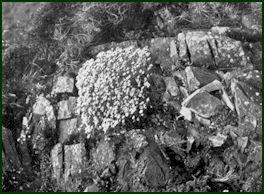| 1. Symposia / Historical Safaris
3. Research 4. Surveys
7. Folklore 9. Contact us 11. Links |
According to Praeger, the most important findings were two members of the saxifrage family:saxifraga geum, hitherto known only from Cork and Kerry and the Pyrenees and saxifraga decipiens whose only known location elsewhere in Ireland is on Slieve Mish. Croaghmore forms the only island station for almost all these species as well as wood anemone, common milkwort, stone bramble and water avens. In addition to the rare alpine flora, (which is, incidently, extremely difficult to see for oneself unless one has a strong head for heights),there are a few other areas of the island which are interesting from a vegetational point of view. On the southeast point of the island, just north of the hotel, the V-shaped storm beach of Kinnacorra encloses the only bit of salt marsh on the island. A number of interesting species of rushes grow here. Continuing along the eastern side of the island, in a valley behind another storm beach, known as Portlea, lies the island's only woodland4. which contains mostly birch and hazel, a number of quite large hollies and a few rowan or mountain ash. There are two oaks, one quite stunted, the other a fine tree. Known locally as Lassau, it is agood example of the ancient, post-glacial, secondary phase of wood land growth and would have been heavily coppiced during the last centuries. In recent years, the grazing stock has been removed from the surrounding land and the birch and hazel are reseeding themselves. In the valley to the north of the woodland, a mixture of 2,500 broadleaved trees have been planted, including 600oaks. Mediterranean Heather Mediterranean heather grows in one area of the
small easterly facing cliffs, north east of Lassau.
|
 The seaward slope of Croaghmore or the Big Hill bears an interesting
natural community, only grazed in small patches because of its steepness. These are the
‘star’ alpine species of the original botanical survey. This part of the island
was declared an Area of Scientific Interest (ASI) by the Irish state, ten years ago, and
provides the basis for the island's present status as a Natural Heritage Area (NHA).Mossy
campion (silene acaulis) is abundant, extending down to 120 m, and growing with
mountain sorrel (Oxyriadigyna), roseroot, (Rhodiola rosea),
St.Patrick’s cabbage (saxifraga spathularis), and a kidney-leaved saxifrage of
hybridorigin (S. spathularis x geum). The later two species overlap with the
maritime flora of thrift (Armeria maritima) and red fescue (Festuca rubra)
towards the base of the cliffs
The seaward slope of Croaghmore or the Big Hill bears an interesting
natural community, only grazed in small patches because of its steepness. These are the
‘star’ alpine species of the original botanical survey. This part of the island
was declared an Area of Scientific Interest (ASI) by the Irish state, ten years ago, and
provides the basis for the island's present status as a Natural Heritage Area (NHA).Mossy
campion (silene acaulis) is abundant, extending down to 120 m, and growing with
mountain sorrel (Oxyriadigyna), roseroot, (Rhodiola rosea),
St.Patrick’s cabbage (saxifraga spathularis), and a kidney-leaved saxifrage of
hybridorigin (S. spathularis x geum). The later two species overlap with the
maritime flora of thrift (Armeria maritima) and red fescue (Festuca rubra)
towards the base of the cliffs